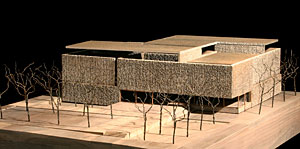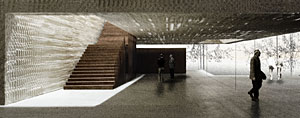Denver’s Clyfford Still Museum, set to open in 2010, will be a “a series of spaces that provide moments for introspection and repose,” according to Brad Cloepfil, principal of Allied Works Architecture, who unveiled his design at a press conference yesterday. The 31,500-square-foot building will sit in the shadow—literally—of the Denver Art Museum’s 2006 addition, designed by Daniel Libeskind.



Images courtesy Clyfford Still Museum
Brad Cloepfil, principal of Allied Works Architecture, has unveiled his design for the Clyfford Still Museum in Denver (top). The main lobby (middle). Typical galleries (above).
In contrast to the Libeskind building, with its jutting angles of titanium, Cloepfil’s museum is a two-story, rectangular structure of textured concrete and glass set in a tree-lined plaza. Visitors will enter it by way of a cantilevered concrete canopy. A wooden staircase will take them to the second-floor galleries, where Still’s work will be displayed in 10,000 square feet of exhibition space. Natural light, via clerestory windows, will illuminate most of the galleries.
Still was a leading figure in the American abstract expressionist movement. When he died in 1980, more than 2,000 pieces of his art, comprising 94 percent of his total output, were locked away in storage. His will stipulated that the collection would be given to an American city that promised to build a museum devoted exclusively to the artist. Denver, which has sought to raise its cultural profile in recent years, jumped at the chance to build the museum. Construction on the $33 million project is expected to begin in early 2009.
In addition to gallery space, where visitors will see a rotating series of exhibitions drawn from Still’s work, the museum will include a conservation studio, educational and storage facilities, and administrative offices. As stipulated by Still, the museum will not have a restaurant or an auditorium.
Cloepfil, who admitted to being a “student of mid-century art,” said that he found inspiration in Still’s work: “His paintings are both immediate and expansive, exploring the textures and colors of the earth, the passing clouds, the fires of the cosmos.” He added that his goal was to provide a setting that allows visitors to form an “intimate relationship” with Still’s paintings and drawings. Central to creating this atmosphere could be the museum’s textured concrete walls. Their texture will come from either crushed quartz or obsidian, which will diffuse and refract daylight entering the galleries.
Museum director Dean Sobel said he was “ecstatic” about Cloepfil’s design, adding that he is especially happy to see that the museum’s galleries will take advantage of the unique quality of light afforded by Denver’s intense, blue skies. When it comes to paintings, he explained, “the temptation is to over-light, but we’ll be calling on nature to do that, principally. Brad has figured out that frisson between art and architecture. I don’t think anyone could have nailed it quite the way he has.”




Post a comment to this article
Report Abusive Comment